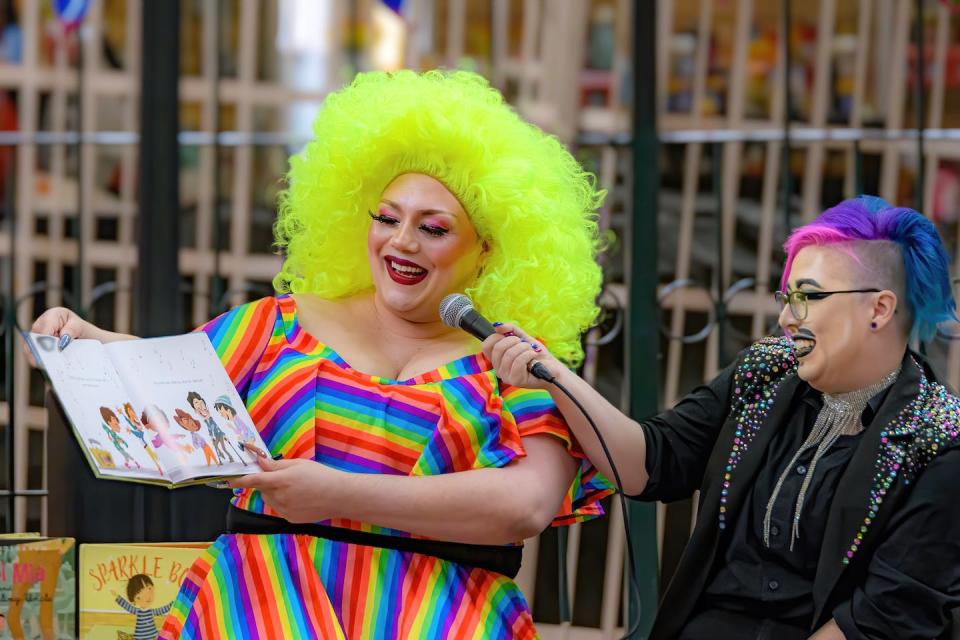Five things to know about Drag Queen Story Time

Recent news reports have described the public controversy involving topics of sexual orientation and gender identity, and how these are presented to children, especially in schools and libraries. Protests at Ontario, British Columbia, Alberta and New Brunswick libraries and public centres have targeted Drag Queen Story Time events.
These are educational events where drag performers read books to children. The aim is to present the diversity of gender expression and identity, build acceptance and develop creativity in personal expression.
Recently, however, these events have been met with backlash. School leaders have prevented children from attending events that discuss sexual and gender identity. In New Brunswick, where the provincial government is reviewing gender identity policy in schools due to public pressure, Premier Blaine Higgs put the question plainly: “Should [there] be drag story time for young kindergarten, grade 1, grade 2?”
Through our research and clinical practice working with children, parents and schools, we believe parents and kids deserve a better understanding of what events like drag story times are about.

Contrary to misconceptions, exposing children to diverse gender identities and expressions supports their natural development. Further, it fosters inclusive and accepting communities and school environments, which is fundamental for developing well-adjusted adults.
Parents play a critical role in providing nurturing environments for their children. This can be best accomplished when parents are well-informed on topics that dominate mainstream media.
What is drag?
Drag is an art form that has been around for centuries, including during the First World War. Drag has evolved within gay culture, can be performed by all genders and is generally an exaggeration of gender expression.
A drag performance combines elements of fashion, makeup, dance, lip-syncing, music and comedy. It is important to remember that, like other forms of art, it is available on a wide spectrum: from mature themes at a night club, to child-friendly performances that would be appropriate for schools, libraries and community centres.
What happens at a Drag Queen Story Time?
Drag Queen Story Time began in San Francisco in 2015. The events generally occur in public spaces like libraries, schools or community centres, with a drag queen host. Children most often attend with their families, parents and teachers. While the host adheres to the flamboyant art form in terms of colours and fashion, it is not a mature performance with sexualized overtones. Neither is it an opportunity for the host to groom children.
The host will read a story book to the children, often one promoting themes of acceptance, diversity and self-expression, presenting characters and families from diverse backgrounds. The host will also often interact with the participants, answering questions the children may have, playing games, making crafts or posing for photographs with the children. The overall aim of the event is to provide a positive message to children about the diversity of gender expression.
How do children develop their gender identities?
The development of gender identities in children is a complex process. It is influenced by a combination of factors, including biological, social, cognitive, environment and personal exploration. Children eventually develop a relative clarity of their gender and feel a sense of harmony between the complex factors that contribute to gender identity development.
In some children, these factors may conflict, most commonly when children do not conform to societal expectations of their assigned sex at birth. This can result in negative emotions and lead to behavioural or mental health issues. These issues are often remediated when gender-affirming care is provided.
Introducing children to diverse gender expressions does not encourage gender dysphoria or confusion. On the contrary, diverse experiences throughout life have been shown to foster self and collective understandings of gender and gender differences. Furthermore, it’s important for a child’s development that parents, schools and communities support children in their exploration and expression of gender identity in a safe and affirming environment.

The importance of positive role models
Children and youth who identify as 2SLGBTQI+ usually have little-to-no access to positive role models that can relate to their own experiences. Having access to positive role models and having positive experiences with people who have diverse gender identities can foster a better sense of belonging and promote self-acceptance.
People who are successful and positive role models are characterized as being competent and easily relatable. Such role models provide context for children to gain a better understanding of themselves and others. Further, adolescents whose gender or sexual identity is accepted by their parents experience fewer psychological problems compared to those whose parents are less accepting.
How can parents engage with Drag Queen Story Time?
Engaging with drag performers is an opportunity for parents to show their children that diversity is beautiful and worthy of celebration. Parents can foster engagement through communication and understanding of their own emotions and their child’s emotions. Being in tune with these emotional components helps ensure children are in an environment that supports positive development and growth.
Attending family-friendly drag events with children creates opportunities for discussion and reflection. Parents can think about and reflect on their own development of gender identity and expression, what influenced the choices they’ve made, and how this may impact the choices that their children may make. After Drag Queen Story Time, parents are sure to have important conversations with their children that will not only increase their understanding of self-identity, but of identities of others as well.
This article is republished from The Conversation, an independent nonprofit news site dedicated to sharing ideas from academic experts. If you found it interesting, you could subscribe to our weekly newsletter.
It was written by: Conor Barker, Mount Saint Vincent University and Daniel G. Seguin, Mount Saint Vincent University.
Read more:
The authors do not work for, consult, own shares in or receive funding from any company or organisation that would benefit from this article, and have disclosed no relevant affiliations beyond their academic appointment.

